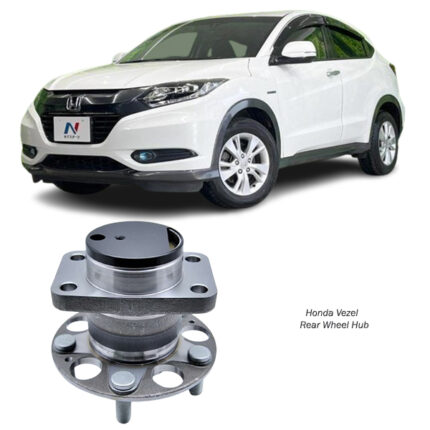Get Honda Vezel DBA Rear brake pads DB2355SS in Kenya
Behind every smooth and controlled stop lies a set of robust, precision-engineered components working in harmony. At the core of this system is the rear brake pad—a compact yet critical part responsible for converting momentum into safety.
Often overlooked in favor of its front counterparts, the rear brake pad plays a vital role in ensuring balance, stability, and efficiency during braking. Let’s explore what makes rear brake pads essential, how they work, their structure, and the numerous benefits they bring to every ride.
What Are Rear Brake Pads?
Rear brake pads are friction materials installed in disc brake systems at the rear of a vehicle. When the brake pedal is pressed, these pads press against the brake rotors, creating friction that slows and eventually stops the rotation of the wheels.
Their purpose is simple but essential:
Provide consistent stopping power
Manage heat during braking
Work in tandem with front brakes to ensure balanced deceleration
Improve driving stability, especially during emergency stops or slippery conditions
Despite carrying a smaller portion of the braking load than front pads, rear brake pads contribute to vehicle balance, control, and long-term system integrity.
How Rear Brake Pads Work
-
Brake pedal is pressed Brake fluid activates the caliper piston.
-
Caliper piston pushes rear brake pads against the spinning rotor.
-
Friction is generated between the pad material and the rotor surface.
-
Kinetic energy is converted into heat energy, slowing the wheel.
-
Pads retract when the pedal is released, allowing free wheel rotation again.
It’s a process that happens in milliseconds, thousands of times across the life of the brake pad—yet always with the goal of achieving controlled, confident stopping.
Construction and Materials
Rear brake pads are composed of several key layers, each contributing to performance, durability, and safety:
-
Friction material: This is the outermost surface that contacts the rotor. It may be:
-
Semi-metallic (durable, high heat tolerance)
-
Ceramic (low dust, quiet performance)
-
Organic/NAO (softer, environmentally friendly)
-
-
Backing plate: A strong steel plate bonded to the friction material to provide structural support and resist warping.
-
Shim/insulation layers: These reduce vibrations and noise during braking.
-
Adhesives and bonding agents: High-temperature adhesives bond the friction material to the backing plate, ensuring it stays in place under extreme conditions.
The perfect blend of these components results in a pad that resists wear, withstands heat, and delivers quiet, smooth braking.
Key Features and Benefits
Rear brake pads might be small in size, but their benefits are enormous:
Balanced Braking
While front brakes handle the majority of braking force, rear pads are crucial for balanced deceleration. They help maintain vehicle posture and control, especially when braking on curves or in rain.
Noise and Vibration Reduction
Modern rear brake pads are engineered with noise-reducing shims and chamfered edges that minimize squeals and vibrations for a quiet driving experience.
Longer Service Life
Due to their role and lighter load compared to front pads, rear brake pads typically wear more slowly, often lasting longer—though timely maintenance remains key.
Improved Safety
High-quality rear pads ensure even brake distribution and prevent rear-wheel lockups during emergency braking, contributing to overall vehicle safety.
Dust Reduction
Especially in ceramic and low-metallic options, rear pads are formulated to produce less brake dust, keeping surrounding components cleaner for longer.
Heat Management and Performance
When brakes are applied, significant heat is generated due to friction. Effective heat dissipation is essential to avoid:
-
Brake fade (temporary loss of braking power)
-
Rotor warping
-
Pad glazing (hardened pad surface reducing effectiveness)
Rear brake pads are designed to:
-
Tolerate high temperatures
-
Maintain frictional performance
-
Minimize wear at both high and low speeds
This ensures reliable braking even during prolonged descents, stop-and-go traffic, or heavy-load driving.
Installation & Maintenance
Most rear brake pads are installed in caliper assemblies mounted on brake discs. Maintenance involves:
-
Visual inspections for wear or uneven surfaces
-
Thickness checks (minimum safe thickness is usually around 3 mm)
-
Replacement at service intervals (typically every 30,000–70,000 km, depending on usage and environment)
Proper installation includes cleaning the caliper, applying anti-seize or brake lubricant to contact points, and ensuring all clips and shims are secured.
Signs of Worn Rear Brake Pads
Worn brake pads can compromise safety and should be replaced as soon as symptoms appear. Common signs include:
Squealing or grinding noises
Increased stopping distance
Vibration or pulsing brake pedal
Brake warning light
Visible wear on pads (thin or uneven surfaces)
Ignoring these signs can lead to rotor damage, brake failure, or expensive repairs. Prevention through regular inspection is always better than cure.
Types of Rear Brake Pads
There are various options available based on material and performance needs:
-
Ceramic Brake Pads
-
Quiet, clean, and long-lasting
-
Ideal for urban driving and everyday use
-
Lower dust generation
-
-
Semi-Metallic Brake Pads
-
High-performance under stress
-
Better for heavy loads or more aggressive driving
-
Louder and more abrasive to rotors
-
-
Organic (NAO) Pads
-
Eco-friendly and softer
-
Gentle on rotors
-
Shorter lifespan
-
Choosing the right pad type depends on driving conditions, desired performance, and environmental impact.
Follow us on Facebook for more parts.




